2010 VOLKSWAGEN TOUAREG ECO mode
[x] Cancel search: ECO modePage 426 of 684

Defensive driving and “flowing” with traffic
Frequent braking and acceleration increases fuel consumption significantly. Just by driving defensively and keeping a sufficiently large distance away from the vehicle in front of you can make up for the speed fluctuations caused by taking your foot off the accelerator. Active braking and accelerating is then not necessarily required.
Calm and smooth driving
Consistency is more important than speed. The more smoothly you drive, the less fuel the vehicle consumes.
When driving on the highway or freeway, a constant, moderate speed is more efficient and economical than constantly accelerating and braking. Usually you can reach your destination just as quickly by driving at a moderate, but steady speed.
The cruise control system can assist in maintaining a uniform driving style.
Moderate use of extra electrical loads
Comfort inside the vehicle is nice and important, but it is important to use them in an environmentally conscious manner.
Some devices can increase fuel consumption when activated (examples):
�x Climate control system (air conditioner): If the climate control system has to produce starkly con-trasting temperatures, it requires a large amount of energy, which is generated by the engine. The temperature in the vehicle should therefore not be extremely different from that of the outside tempera-ture. It may be helpful to ventilate the vehicle before driving and then to drive a short distance with the windows open. After that, switch on the air conditioner with the windows closed. Keep the windows closed when driving at high speeds. Open windows increase fuel consumption.
�x Switch off seat heating once it has served its purpose.
�x Switch off the windshield and rear window defroster as soon as the windows are free of fog and ice.
Additional factors that increase fuel consumption (examples):
�x Malfunctioning engine control.
�x Driving in the mountains.
�x Towing a trailer.
NOTICE
Never let the vehicle coast or roll down a hill in Neutral (N), especially when the engine is not running. The transmission will not be lubricated and will be damaged.
See additional tips on using your hybrid drive to help reduce fuel consumption.
Page 491 of 684
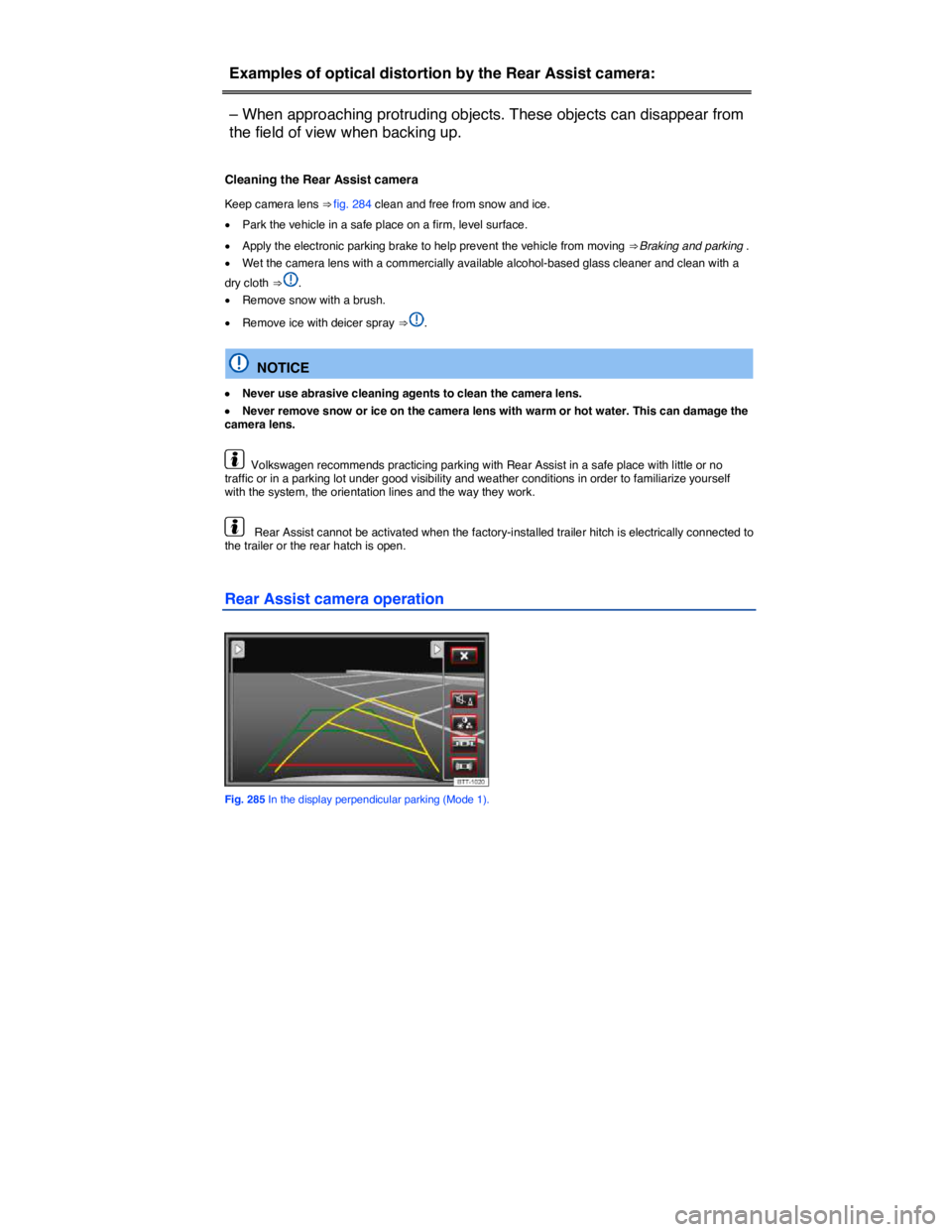
Examples of optical distortion by the Rear Assist camera:
– When approaching protruding objects. These objects can disappear from
the field of view when backing up.
Cleaning the Rear Assist camera
Keep camera lens ⇒ fig. 284 clean and free from snow and ice.
�x Park the vehicle in a safe place on a firm, level surface.
�x Apply the electronic parking brake to help prevent the vehicle from moving ⇒Braking and parking .
�x Wet the camera lens with a commercially available alcohol-based glass cleaner and clean with a
dry cloth ⇒ .
�x Remove snow with a brush.
�x Remove ice with deicer spray ⇒ .
NOTICE
�x Never use abrasive cleaning agents to clean the camera lens.
�x Never remove snow or ice on the camera lens with warm or hot water. This can damage the camera lens.
Volkswagen recommends practicing parking with Rear Assist in a safe place with little or no traffic or in a parking lot under good visibility and weather conditions in order to familiarize yourself with the system, the orientation lines and the way they work.
Rear Assist cannot be activated when the factory-installed trailer hitch is electrically connected to the trailer or the rear hatch is open.
Rear Assist camera operation
Fig. 285 In the display perpendicular parking (Mode 1).
Page 493 of 684

Function With the ignition switched on
Vehicles without Park
Distance Control
Vehicles with Optical
Parking System
Switch on the
display
automatically:
Shift into Reverse (R)
Mode 1 is displayed in the factory-installed radio or naviga-
tion system ⇒ fig. 285.
Additionally, the mini-OPS
will be displayed on the left
edge of the factory-installed
radio or navigation system
screen.
Switch off the
display
automatically:
Turn off the ignition
OR: Drive forward faster
than about 9 mph (15 km/h),
or longer than about 10
seconds.
OR: Immediately after shift-
ing out of Reverse (R).
OR: about 10 seconds after
shifting out of Reverse (R).
Hide the
Rear Assist
display:
Press one of the factory-installed radio or navigation sys-
tem buttons or tap the �O function key.
The display will hide after about 10 seconds.
OR: Tap the function key •.
The OPS will be displayed
full-screen.
Show the
Rear Assist
display
again:
Shift into another gear position then back into Reverse (R).
OR: Tap the function key
�Z.
Page 499 of 684
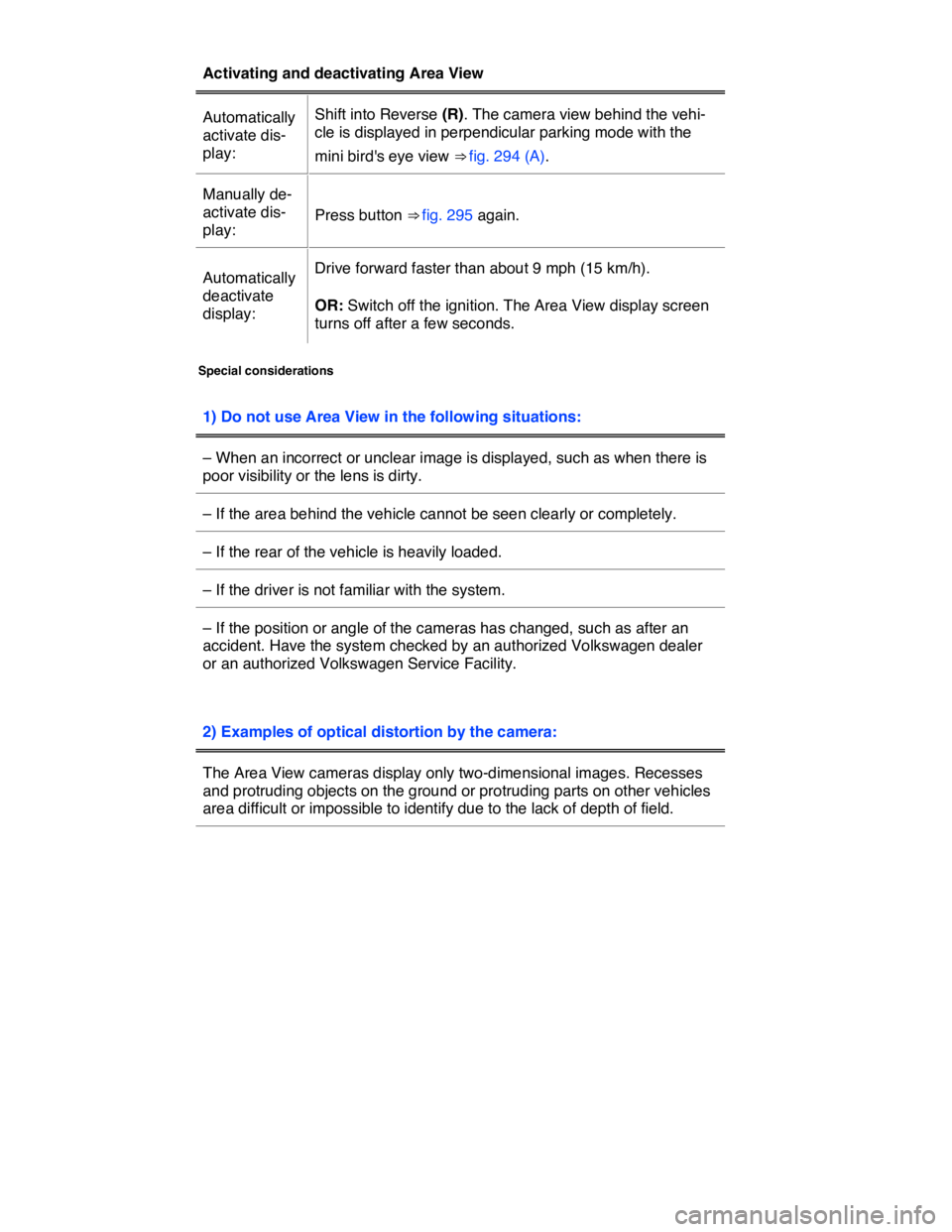
Activating and deactivating Area View
Automatically
activate dis-
play:
Shift into Reverse (R). The camera view behind the vehi-
cle is displayed in perpendicular parking mode with the
mini bird's eye view ⇒ fig. 294 (A).
Manually de-
activate dis-
play: Press button ⇒ fig. 295 again.
Automatically
deactivate
display:
Drive forward faster than about 9 mph (15 km/h).
OR: Switch off the ignition. The Area View display screen
turns off after a few seconds.
Special considerations
1) Do not use Area View in the following situations:
– When an incorrect or unclear image is displayed, such as when there is
poor visibility or the lens is dirty.
– If the area behind the vehicle cannot be seen clearly or completely.
– If the rear of the vehicle is heavily loaded.
– If the driver is not familiar with the system.
– If the position or angle of the cameras has changed, such as after an
accident. Have the system checked by an authorized Volkswagen dealer
or an authorized Volkswagen Service Facility.
2) Examples of optical distortion by the camera:
The Area View cameras display only two-dimensional images. Recesses
and protruding objects on the ground or protruding parts on other vehicles
area difficult or impossible to identify due to the lack of depth of field.
Page 514 of 684
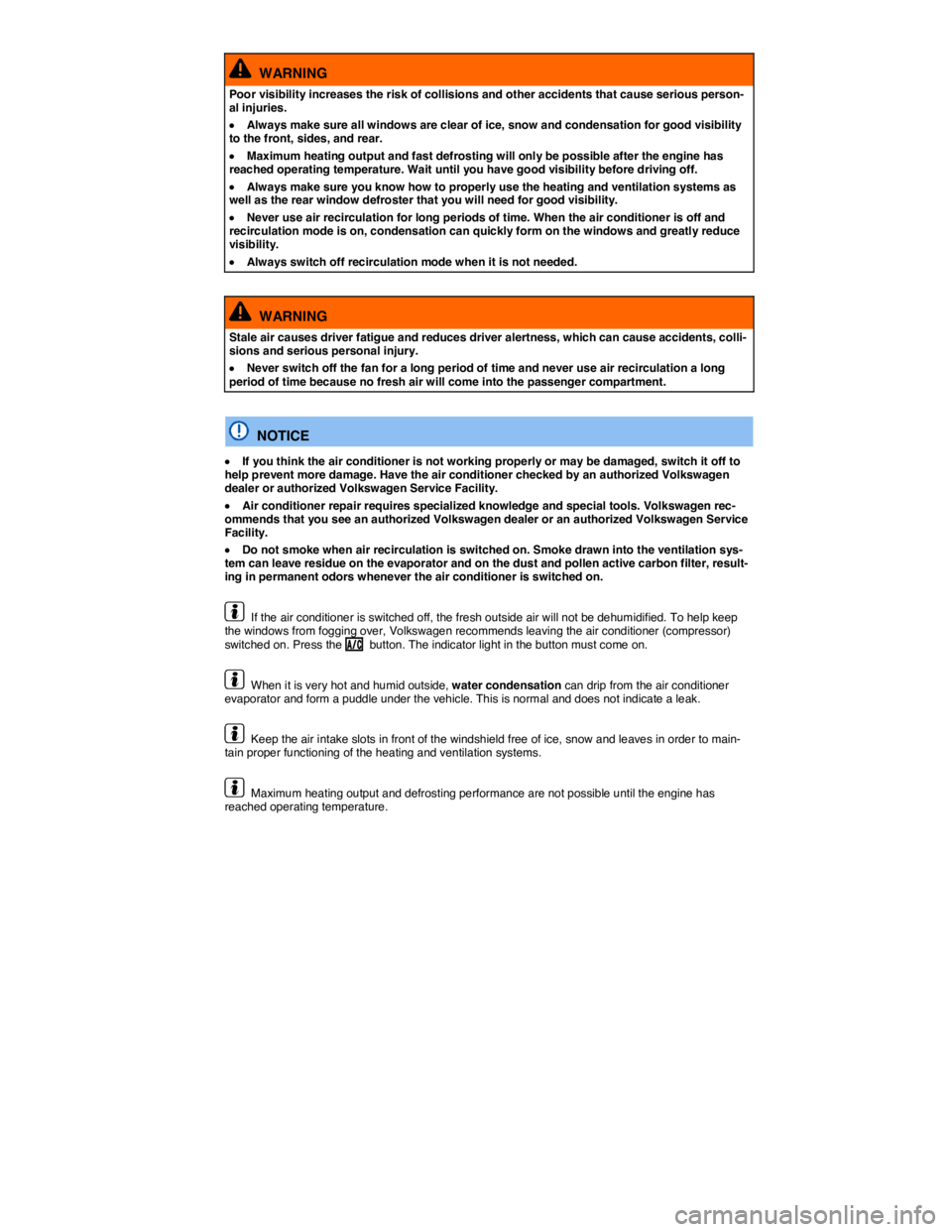
WARNING
Poor visibility increases the risk of collisions and other accidents that cause serious person-al injuries.
�x Always make sure all windows are clear of ice, snow and condensation for good visibility to the front, sides, and rear.
�x Maximum heating output and fast defrosting will only be possible after the engine has reached operating temperature. Wait until you have good visibility before driving off.
�x Always make sure you know how to properly use the heating and ventilation systems as well as the rear window defroster that you will need for good visibility.
�x Never use air recirculation for long periods of time. When the air conditioner is off and recirculation mode is on, condensation can quickly form on the windows and greatly reduce visibility.
�x Always switch off recirculation mode when it is not needed.
WARNING
Stale air causes driver fatigue and reduces driver alertness, which can cause accidents, colli-sions and serious personal injury.
�x Never switch off the fan for a long period of time and never use air recirculation a long period of time because no fresh air will come into the passenger compartment.
NOTICE
�x If you think the air conditioner is not working properly or may be damaged, switch it off to help prevent more damage. Have the air conditioner checked by an authorized Volkswagen dealer or authorized Volkswagen Service Facility.
�x Air conditioner repair requires specialized knowledge and special tools. Volkswagen rec-ommends that you see an authorized Volkswagen dealer or an authorized Volkswagen Service Facility.
�x Do not smoke when air recirculation is switched on. Smoke drawn into the ventilation sys-tem can leave residue on the evaporator and on the dust and pollen active carbon filter, result-ing in permanent odors whenever the air conditioner is switched on.
If the air conditioner is switched off, the fresh outside air will not be dehumidified. To help keep the windows from fogging over, Volkswagen recommends leaving the air conditioner (compressor) switched on. Press the �!�
Page 553 of 684
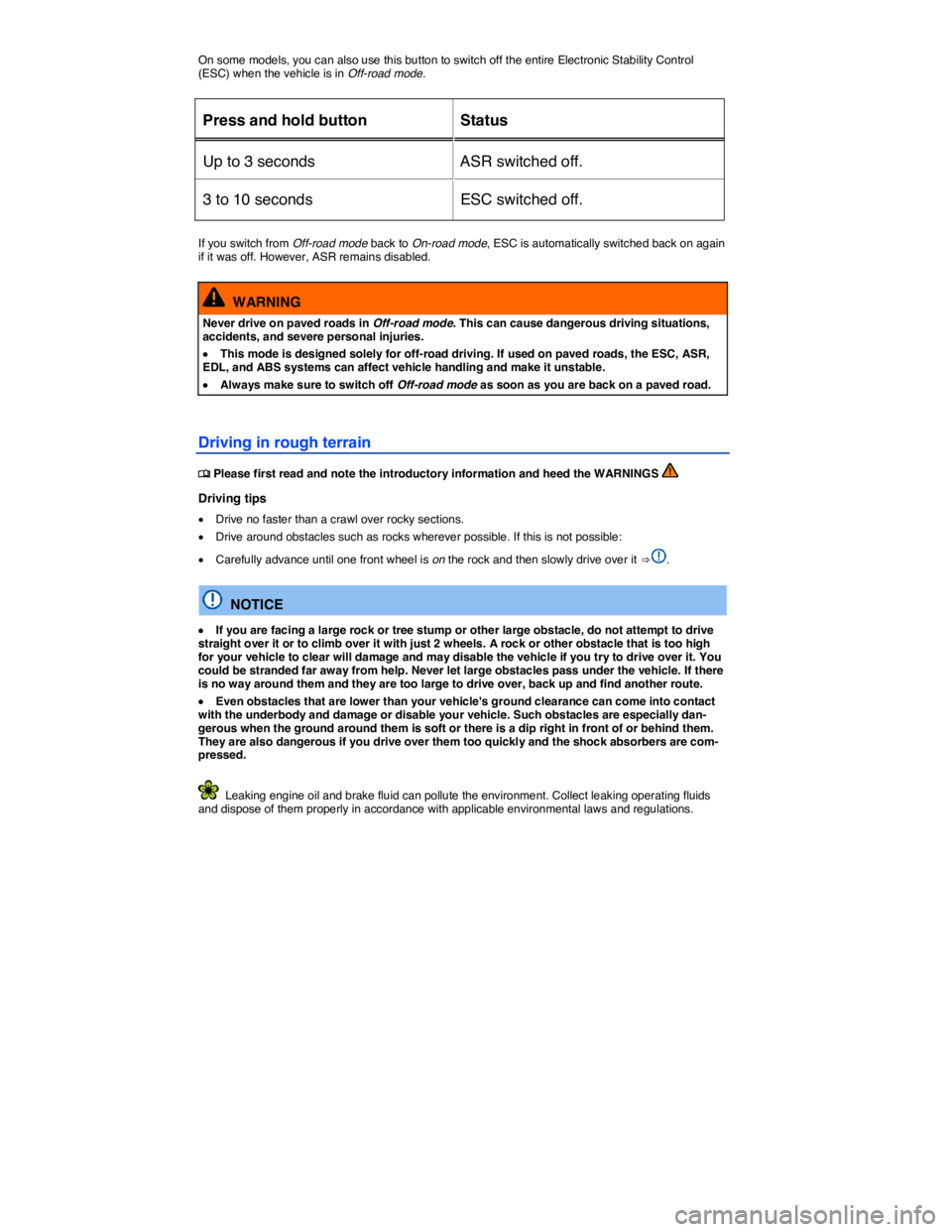
On some models, you can also use this button to switch off the entire Electronic Stability Control (ESC) when the vehicle is in Off-road mode.
Press and hold button Status
Up to 3 seconds ASR switched off.
3 to 10 seconds ESC switched off.
If you switch from Off-road mode back to On-road mode, ESC is automatically switched back on again if it was off. However, ASR remains disabled.
WARNING
Never drive on paved roads in Off-road mode. This can cause dangerous driving situations, accidents, and severe personal injuries.
�x This mode is designed solely for off-road driving. If used on paved roads, the ESC, ASR, EDL, and ABS systems can affect vehicle handling and make it unstable.
�x Always make sure to switch off Off-road mode as soon as you are back on a paved road.
Driving in rough terrain
�
Page 618 of 684

Therefore we strongly recommend that you use your cellular telephone in your vehicle only when it is properly attached to an appropriate cradle mounted on a base plate on the instrument panel.
Because of the large number and variety of cellular telephones on the market and the frequency with which new models are introduced, Volkswagen does not offer cradles for cellular telephones. Please check with the manufacturer of the cellular telephone that you plan to use.
WARNING
A mobile phone on the seat, instrument panel or in other places can be thrown around the inside of the vehicle during a sudden braking maneuver, a crash or other accident and injure vehicle occupants.
�x Never place or attach accessories or other objects (such as cup holders, telephone brack-ets, note pads, navigation systems, large, heavy or bulky objects) on the doors, on the wind-shield, over or near the area marked “AIRBAG” on the steering wheel, instrument panel, backrests or between these areas and the occupant. Such objects could cause serious injury in a collision, especially if an airbag inflates.
WARNING
Using a mobile phone or CB radio inside the vehicle without a properly installed and separate outside antenna can be dangerous to your health and that of your passengers because the electromagnetic radiation energy that mobile phones and CB radios emit may be above es-tablished limits. This also applies if the outside antenna is not installed properly.
�x Always keep the mobile phone antenna at least 8 inches (20 cm) away from pacemakers. Heart specialists advise that mobile phones can adversely affect the way of pacemakers work.
�x Never carry a mobile phone that is switched on in the breast pocket directly over the pacemaker.
�x If you suspect there may be interference with a pacemaker or other medical device, switch the mobile phone off immediately.
Page 656 of 684
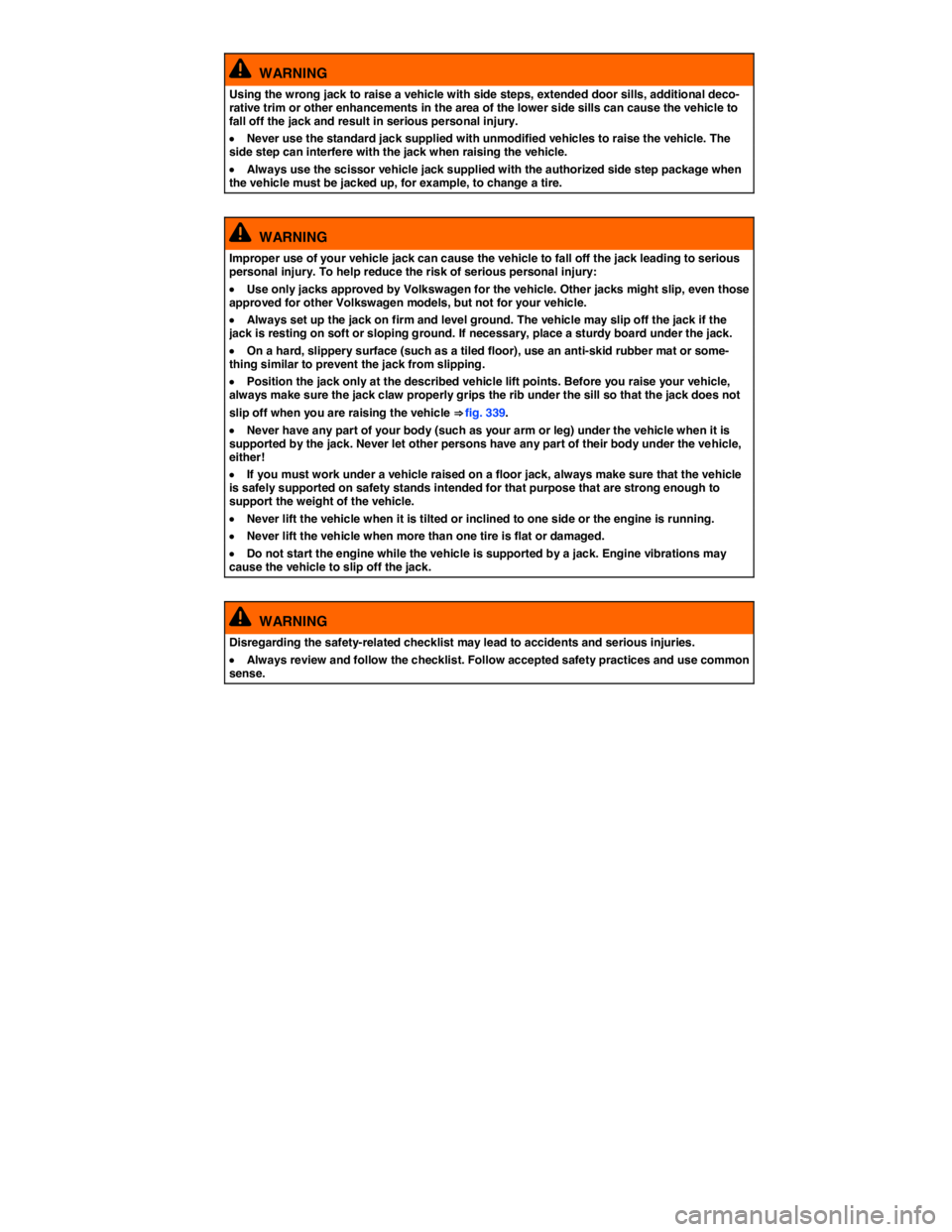
WARNING
Using the wrong jack to raise a vehicle with side steps, extended door sills, additional deco-rative trim or other enhancements in the area of the lower side sills can cause the vehicle to fall off the jack and result in serious personal injury.
�x Never use the standard jack supplied with unmodified vehicles to raise the vehicle. The side step can interfere with the jack when raising the vehicle.
�x Always use the scissor vehicle jack supplied with the authorized side step package when the vehicle must be jacked up, for example, to change a tire.
WARNING
Improper use of your vehicle jack can cause the vehicle to fall off the jack leading to serious personal injury. To help reduce the risk of serious personal injury:
�x Use only jacks approved by Volkswagen for the vehicle. Other jacks might slip, even those approved for other Volkswagen models, but not for your vehicle.
�x Always set up the jack on firm and level ground. The vehicle may slip off the jack if the jack is resting on soft or sloping ground. If necessary, place a sturdy board under the jack.
�x On a hard, slippery surface (such as a tiled floor), use an anti-skid rubber mat or some-thing similar to prevent the jack from slipping.
�x Position the jack only at the described vehicle lift points. Before you raise your vehicle, always make sure the jack claw properly grips the rib under the sill so that the jack does not
slip off when you are raising the vehicle ⇒ fig. 339.
�x Never have any part of your body (such as your arm or leg) under the vehicle when it is supported by the jack. Never let other persons have any part of their body under the vehicle, either!
�x If you must work under a vehicle raised on a floor jack, always make sure that the vehicle is safely supported on safety stands intended for that purpose that are strong enough to support the weight of the vehicle.
�x Never lift the vehicle when it is tilted or inclined to one side or the engine is running.
�x Never lift the vehicle when more than one tire is flat or damaged.
�x Do not start the engine while the vehicle is supported by a jack. Engine vibrations may cause the vehicle to slip off the jack.
WARNING
Disregarding the safety-related checklist may lead to accidents and serious injuries.
�x Always review and follow the checklist. Follow accepted safety practices and use common sense.